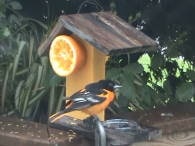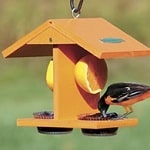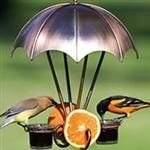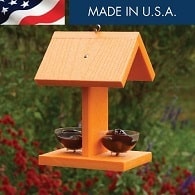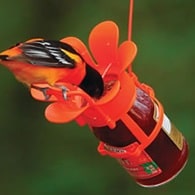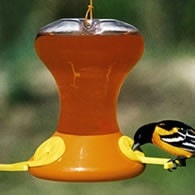Bullock's Oriole: Nature's Bright Gem
The Bullock's Oriole is the western counterpart to the Baltimore Oriole bird found east of the Rockies.
In the mid-1980s, ornithologists concluded the two are one bird species uniting them under a new name: Northern Oriole.
Leaving their wintering grounds in Mexico and South America, you'll begin seeing and hearing them by mid-April to mid-May.
Once they reach their breeding territories in western North America, they'll begin claiming territory, finding mates, building nests, and raising young.
Bullocks Oriole Call
Description
Bullock's Orioles measure between 7 to 8 1/2 inches long. The male Bullock's have an orange face with a black eyeline and a large white wing patch.
The black on its head is significantly less than the Baltimore.
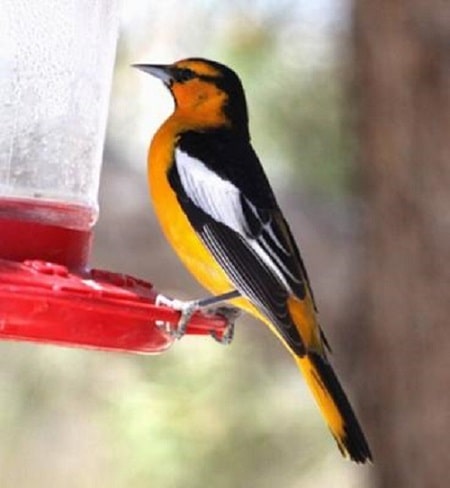
Bullock's Oriole on Hummingbird Feeder
A black eye line can be seen on the males. A bold white patch on the wing and entirely orange outer tail feathers.
The female has a yellowish head and breast with a whitish belly. Immatures look similar to females.
Mating and Courtship Habits
Bullock's are monogamous during the nesting season but do not mate for life. Their distinctive mating and courtship behaviors are detailed below.
During courtship, the male will perform an elaborate display, including singing, fluffing up his feathers, and presenting food to the female.
Bullock's Oriole Eating Orange
This display is intended to attract a mate and establish a bond between the two birds. Once a pair has formed, they will work together to build a nest and raise their young.
Nesting Habits
The Bullock's nest is best seen in winter when the trees are bare. Like its eastern counterpart, the Bullock's have the signature woven hanging nest, suspended from the very tips of branches.
The female selects the nest site and is the main nest builder. Males will help from time to time.
The nest is made of tightly woven plant fibers, dried grasses, and string placed 6 to 60 feet above the ground. The nest can take up to 2 weeks to complete.
| Bullocks-Oriole Nesting Stats | |
|---|---|
| Eggs | 4 - 6 |
| Incubation | 12 - 14 days |
| Nestling Phase | 12- 14 days |
| Broods | 1 |
The female lays 4 to 6 eggs that are pale bluish-white with dark marks. Incubation is done by the female and last 12 - 14 days.
The young are fed by both adult birds and will leave the nest in 12 - 14 days after hatching.
Feeding Habits
Bullock's orioles eat insects, fruits, and flower nectar, and will readily come to fruit feeders and hummingbird feeders.
Bird watchers who want to attract these birds to their feeders can place orange halves, sugar solutions, and grape jelly out.
While raising their young, the adults will feed an insect diet to the nestlings. Once fledged, the adults may bring them to your summer bird feeding station if you provide oranges and grape jelly.
Fall Migration
Mostly, fall migration begins in late July and may go into September, depending on how far North they nested.
Some Bullock's orioles may winter in southern California. All in all, September is the final month on any nesting grounds.
